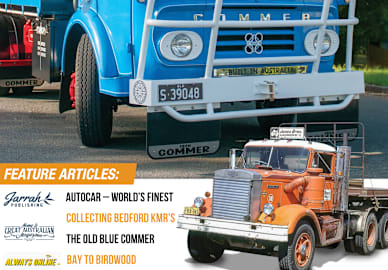Once the Second World War had ended and the 1950’s decade was starting, motor vehicle manufacturers were beginning to look again at expanding their markets and models to keep abreast of the ever-growing demand for motor vehicles from private, business and government buyers.
Ford in the USA had relaunched their truck line-up with the ‘Freighter’ models post-War and, in 1948, introduced the First Generation ‘F’ Series trucks, the F1 light duty to F8 heavy duty. For the Australian market, the F6 heavy duty model would be the biggest Ford truck offered.
These first generation Ford trucks were easily identified with a series of horizontal grille bars and headlamps set into the mudguards. For the 1951 model year, Ford dropped the horizontal bars and introduced what is regarded as a aerodynamic cross piece with three prominent supports. The headlamps were set into each end, with distinctive parking lamps underneath. At the same time, the rear cab window became larger, along with a new instrument panel. The new cab would be called the ‘Five Star Cab’.

The Ford F6 in this article was released and sold, probably during 1951 (as best as we can ascertain), to a builder based in the Adelaide suburb of Thebarton. Unfortunately, the painted signage on the doors has faded to the point where the owner’s name is no longer legible.
From here, it found its way to the Riverland near Loxton to continue working. It is to be remembered that this model is Ford’s heavy duty truck model of 1951, competing in Australia with similar American models from Chrysler (Dodge, De Soto and Fargo), General Motors Holden (Chevrolet and Bedford) and International Harvester.

Some years ago, Dan Haynes of DSM Constructions saw the Ford while in Loxton and, after negotiations with its owner, secured the purchase and brought it down to his landscape supply business located in Middleton on the Fleurieu Peninsula.
Despite showing the results of years of hard work and the ravages of time, the Ford has pride of place in the entrance to the yard.
The F6 is powered by Ford’s now ubiquitous side valve V8, incorporating a number of improvements that we truck mechanics loved, for it was now an engine that was much easier to work on from a maintenance and repair aspect.
From 1948, Ford replaced the mushroom-stemmed valves with two- piece guides for straight-stemmed valves and one piece guides.
Having worked on pre-1948 engines as a motor mechanic apprentice with Ray Wolfenden in South Geelong, Victoria, this was a quantum step forward. Also, the ignition distributor, known as the ‘Load-A-Matic’ was now located at the right front, top of the engine, so it was easy to access!
If you have ever had to fit, set and adjust the earlier ‘crab’ distributor ignition point sets, you know what I mean. Cylinder heads were fitted with 24 bolts rather than studs and nuts, and the bell housing would now be separate from the cylinder block. From 1950 narrow fan belts were introduced.
Ford
F6
Engine
Specification
Model 8RT
Bore 3” (3.1875”)
Stroke 3¾” (3.750”)
Displacement 239cid
BHP 100 at 3,800rpm
Torque (lbs.ft) 180 at 2,000rpm
Compression 6.80:1
Fuel Petrol, Ford - Holley two barrel carburettor.
Engine is fitted with replaceable hardened exhaust valve inserts, deleted from 1952. The truck engine was also identified due to its colour being red (from 1948 to 1951).
On Dan’s Ford V8, it has been fitted with an aftermarket Ryco bypass oil filter (same as available for Holden ‘grey’ engines of the same era) to help keep the engine oil clean as from the Ford factory, the oil was ‘filtered’ by a strainer at the pick up in the sump.

These engines were the same as those that Ford fitted to its passenger cars, the difference being in the oil pan or sump, the shape changing in the truck engine so as not to foul on the front axle.
Engine power in the F6 is transmitted through a four speed manual transmission via an open propeller shaft to a two speed rear axle; the shift uses the engine vacuum to operate.
In Australia, Ford offered one level of interior trim. While this is now regarded as ‘spartan’, in 1951 it was the epitome of comfort, with a full bench seat and two circular gauges in front of the driver, the left one was the speedometer (to 100mph!) and odometer, and the right with four smaller gauges monitoring oil pressure, coolant temperature, fuel tank level and amps. On the left hand side was a glovebox to store incidental items, log book, etc., and the one piece windscreen gave a broad unobstructed view of the road ahead.

The 1953 First Generation F Series would be the last Ford trucks to be fitted with the 8RT side valve V8 engine. In 1954, the Second Generation F Series would be released, fitted with an all new 272cid Y block overhead valve V8 (130bhp) engine. This model designation would become the now familiar F600.
Dan hopes to undertake a restoration of his beloved 1951 Ford F6, as it holds a special place in his future plans. In the meantime, it is very much a wonderful talking point due to its prominent position at the entrance to his landscape business in Middleton. This is truly a ‘Five Star Ford’.
My appreciation to Dan and Sandy at DSM Landscape Supplies, Middleton for their valued assistance with this article. *Paul Tol






